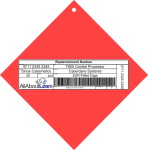![]() Pull production using Kanban is one of the major achievements of the Toyota Production System and hence lean manufacturing. The work in progress is limited by the number of Kanban. Overproduction is avoided by producing only if a part is taken out of the supermarket and the Kanban card is returned to the start of production. However, this Kanban system works only if the Kanban returns to the start of production. Losing Kanban means not reproducing goods sold. In this post I would like to talk about different methods to prevent the loss of Kanban, including different Kanban types.
Pull production using Kanban is one of the major achievements of the Toyota Production System and hence lean manufacturing. The work in progress is limited by the number of Kanban. Overproduction is avoided by producing only if a part is taken out of the supermarket and the Kanban card is returned to the start of production. However, this Kanban system works only if the Kanban returns to the start of production. Losing Kanban means not reproducing goods sold. In this post I would like to talk about different methods to prevent the loss of Kanban, including different Kanban types.
The Problem of Losing Kanban
 Kanban contain information about the type and number of products to be produced, where, and when. A working Kanban circle is essential for a working pull production. In many factories, Kanban is a simple sheet of paper. Unfortunately, in many factories, workers also have the habit of throwing out random sheets of paper found in material bins. In the often-confusing workplace, an important paper Kanban often gets thrown out like an unimportant sheet of scrap paper.
Kanban contain information about the type and number of products to be produced, where, and when. A working Kanban circle is essential for a working pull production. In many factories, Kanban is a simple sheet of paper. Unfortunately, in many factories, workers also have the habit of throwing out random sheets of paper found in material bins. In the often-confusing workplace, an important paper Kanban often gets thrown out like an unimportant sheet of scrap paper.
Or, to bring an even worse example, one plant laminated their Kanban in plastic covers. Unfortunately, these laminated Kanban made excellent ice scrapers for cars. Hence, every winter Kanban started to disappear quickly, since the employees used them to scrape the windows of their cars. Naturally, without Kanban, production started to have hiccups.
Countermeasures Against Losing Kanban
Stable and Robust Kanban Standards
One of the first things you should do for Kanban systems is to make the system robust. Is there a clearly defined place where the Kanban are attached to the material? Is it attached well, or is it likely to fall off during transport? For example, for larger iron products I had good success with magnetic Kanban that simply stuck to the part. Is there a defined place, or does the worker have to walk around the larger part to find the Kanban? Do you have a clearly marked Kanban box at the supermarket and at the start of production? Do you have a visual management to easily see how many Kanban are where? Your Kanban system has to be robust to reduce the likelihood of losing Kanban.
Furthermore, you should not cut your number of Kanban to the bare bones. It is always good to have at least some slack of maybe one additional card, so that the system does not break down immediately if one card goes missing.
Educate Your Workforce

Your workforce needs to know and understand the importance of these Kanban. Kanban need to be treated as important information for your production. In fact, the word Kanban comes from the Japanese word for shop sign, where the sign is not only a sign but the representation of the honor of the establishment.
Hence, you need to train your people about the significance of the Kanban. Importantly, not only the workers handling Kanban on a regular basis need to know about it; others that may or may not handle the Kanban at one point also need to know about it.
Digital Kanban
One way to reduce the losses of Kanban is by going digital, using, for example, an MRP system. You could print out a new copy of the card every time a product needs to be replenished. Hence there would be less handling of the cards, and hence less possibilities to lose them. On the other hand, I am always careful about going digital. In my experience, it usually works well in theory, but in practice there are more than enough problems arising from the use of computer systems. Overall, computers are a mixed blessing. In your case they may work, or maybe not. You decide.
Heavy Metal Kanban

What definitely worked for me was to replace paper Kanban with metal Kanban, in this case attached to pallet cages. The shop floor lost too many paper Kanban, both intentionally (by workers throwing them away) and unintentionally (the cards fell off or slipped underneath the material). Switching to larger 30 x 30-cm painted metal plates with Kanban attached solved this problem.
The metal cards no longer fell off or slipped under the material. Even if they did, the weight of the kanban card also gave mental weight to the worker. Workers no longer threw out these heavy metal Kanban simply because they were heavy and looked important.
Boxes as Kanban
Of course, even bigger and heavier than a metal Kanban is to use the whole box as a kanban. In other words, the information is permanently attached to the box. Rather than returning the Kanban to the start of production, the entire box is returned and refilled. Similar for carts transporting the material, where the Kanban is permanently attached to the entire cart with the material.
No Kanban At All
Of course, the easiest way not to lose Kanban is to not have any in the first place. Unfortunately, this requires some special circumstances and is not always possible. However, it is not impossible. If the manufacturing system is only a single station adjacent to the supermarket, the worker can simply see the content of the supermarket and replenish the material with the least amount of stock. In other words, if the quantity of one product is nearing empty, the worker produces more of this product. However, this works only if the Kanban loop is small, having only one worker and not too many products.
Detecting Lost Kanban
 No matter how good your system is, at one point you will lose a Kanban. Even Toyota loses Kanban sometimes. For that reason, Kanban are usually numbered. Every now and then the number of Kanban have to be checked.
No matter how good your system is, at one point you will lose a Kanban. Even Toyota loses Kanban sometimes. For that reason, Kanban are usually numbered. Every now and then the number of Kanban have to be checked.
For digital Kanban, it is possible to have the system on a look-out automatically. If a number no longer circulates, it may be missing and need to be replenished. Paper Kanban are easiest to count if all the Kanban are in one place. For example, if for one product type all Kanban are in the supermarket, the number of Kanban are easy to count. If only one or two cards are missing, check if they are waiting for or are in production, or if they have been lost.
Such checks for missing Kanban have to be done on a regular basis. For newly established Kanban systems, I would do it more frequently until I got a feeling about the frequency of losing cards. The frequency of such Kanban checks can then be adjusted according to prior experience.
I hope this post was helpful for you. Now go out and improve your industry!

I fear the day I lose my Kanban, really. It’s digital, so shouldn’t happen, but if it was to be the case, my company would suffer. We’re depending on the visualized process completely, as we follow the rule of making any changes in the process represented on the board and stick to it to a tee. I’ve just read a nice article on why is this crucial in order to make Kanban work https://kanbantool.com/blog/problems-with-kanban ) and I’m happy to say I knew this all along. Kanban will not work 1. when it’s lost, and 2. when it doesn’t reflect the actual process.
Hoping that none of us need to go through rebuilding a Kanban any time soon! Thanks for the article.
Hi Tazaki, Many thanks for the input and the good link. Yes, even a kanban system needs some maintenance (check for lost cards, update number of kanban every now and then). Cheers, Chris
Really appreciate your article. Am currently carrying out a consulting contract to determine and carry out improvements for the internal operations of a large chemical manufacturer in the Midwest. Have a few ideas now, thanks!
Hi Nikolai, glad it was helpful for you 🙂
Hello Chris
Thanks for the article,
I really appreciate the idea of metal kanban cards ..
I need more information about the implementation of this idea in a company .
is there also some caracteristics of these cards ? more than its heaviliness
why not work with factors like sound that will make ,magnetic etc
Regards
Hi Elmain, the important thing is that you should not lose your Kanban cards, as this creates havoc with the production system. Hence, you should make the “cards” in a way that they are less likely to be lost (intentionally or unintentionally). Usually anything larger or sturdier (labelled box, metal plate, strong plastic cover with magnet back, …) is much less likely to be thrown out than paper.